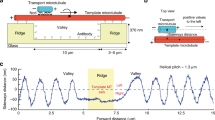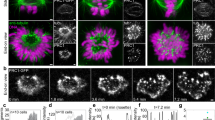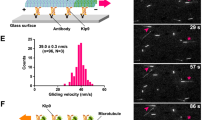Abstract
During cell division the replicated chromosomes are segregated precisely towards the spindle poles1,2. Although many cellular processes involving motility require ATP-fuelled force generation by motor proteins, most models of the chromosome movement invoke the release of energy stored at strained (owing to GTP hydrolysis) plus ends of microtubules3,4. This energy is converted into chromosome movement through passive couplers5,6,7, whereas the role of molecular motors is limited to the regulation of microtubule dynamics. Here we report, that the microtubule-depolymerizing activity of MCAK (mitotic centromere-associated kinesin), the founding member of the kinesin-13 family, is accompanied by the generation of significant tension—remarkably, at both microtubule ends. An MCAK-decorated bead strongly attaches to the microtubule side, but readily slides along it in either direction under weak external loads and tightly captures and disassembles both microtubule ends. We show that the depolymerization force increases with the number of interacting MCAK molecules and is ∼1 pN per motor. These results provide a simple model for the generation of driving force and the regulation of chromosome segregation by the activity of MCAK at both kinetochores and spindle poles through a ‘side-sliding, end-catching’ mechanism.
This is a preview of subscription content, access via your institution
Access options
Subscribe to this journal
Receive 12 print issues and online access
$209.00 per year
only $17.42 per issue
Buy this article
- Purchase on Springer Link
- Instant access to full article PDF
Prices may be subject to local taxes which are calculated during checkout





Similar content being viewed by others


References
Mitchison, T. J. & Salmon, E. D. Mitosis: a history of division. Nat. Cell Biol. 3, E17–E21 (2001).
Wittmann, T., Hyman, A. & Desai, A. The spindle: a dynamic assembly of microtubules and motors. Nat. Cell Biol. 3, E28–E34 (2001).
Desai, A. & Mitchison, T. J. Microtubule polymerization dynamics. Annu. Rev. Cell Dev. Biol. 13, 83–117 (1997).
Grishchuk, E. L., Molodtsov, M. I., Ataullakhanov, F. I. & McIntosh, J. R. Force production by disassembling microtubules. Nature 438, 384–388 (2005).
Asbury, C. L., Gestaut, D. R., Powers, A. F., Franck, A. D. & Davis, T. N. The Dam1 kinetochore complex harnesses microtubule dynamics to produce force and movement. Proc. Natl Acad. Sci. USA 103, 9873–9878 (2006).
Grishchuk, E. L. et al. The Dam1 ring binds microtubules strongly enough to be a processive as well as energy-efficient coupler for chromosome motion. Proc. Natl Acad. Sci. USA 105, 15423–15428 (2008).
Powers, A. F. et al. The Ndc80 kinetochore complex forms load-bearing attachments to dynamic microtubule tips via biased diffusion. Cell 136, 865–875 (2009).
Inoue, S. & Salmon, E. D. Force generation by microtubule assembly/disassembly in mitosis and related movements. Mol. Biol. Cell 6, 1619–1640 (1995).
Wordeman, L. & Mitchison, T. J. Identification and partial characterization of mitotic centromere-associated kinesin, a kinesin-related protein that associates with centromeres during mitosis. J. Cell Biol. 128, 95–104 (1995).
Walczak, C. E., Gan, E. C., Desai, A., Mitchison, T. J. & Kline-Smith, S. L. The microtubule-destabilizing kinesin XKCM1 is required for chromosome positioning during spindle assembly. Curr. Biol. 12, 1885–1889 (2002).
Walczak, C. E. & Mitchison, T. J. Kinesin-related proteins at mitotic spindle poles: function and regulation. Cell 85, 943–946 (1996).
Rogers, G. C. et al. Two mitotic kinesins cooperate to drive sister chromatid separation during anaphase. Nature 427, 364–370 (2004).
Maney, T., Hunter, A. W., Wagenbach, M. & Wordeman, L. Mitotic centromere-associated kinesin is important for anaphase chromosome segregation. J. Cell Biol. 142, 787–801 (1998).
Desai, A., Verma, S., Mitchison, T. J. & Walczak, C. E. Kin I kinesins are microtubule-destabilizing enzymes. Cell 96, 69–78 (1999).
Kline-Smith, S. L. & Walczak, C. E. The microtubule-destabilizing kinesin XKCM1 regulates microtubule dynamic instability in cells. Mol. Biol. Cell 13, 2718–2731 (2002).
Helenius, J., Brouhard, G., Kalaidzidis, Y., Diez, S. & Howard, J. The depolymerizing kinesin MCAK uses lattice diffusion to rapidly target microtubule ends. Nature 441, 115–119 (2006).
Hyman, A. A., Salser, S., Drechsel, D. N., Unwin, N. & Mitchison, T. J. Role of GTP hydrolysis in microtubule dynamics: information from a slowly hydrolyzable analogue, GMPCPP. Mol. Biol. Cell 3, 1155–1167 (1992).
Desai, A., Verma, S., Mitchison, T. J. & Walczak, C. E. Kin I kinesins are microtubule-destabilizing enzymes. Cell 96, 69–78 (1999).
Varga, V. et al. Yeast kinesin-8 depolymerizes microtubules in a length-dependent manner. Nat. Cell Biol. 8, 957–962 (2006).
Müller-Reichert, T., Chrétien, D., Severin, F. & Hyman, A. A. Structural changes at microtubule ends accompanying GTP hydrolysis: information from a slowly hydrolyzable analogue of GTP, guanylyl (α,β)methylenediphosphonate. Proc. Natl Acad. Sci. USA 95, 3661–3666 (1998).
Koshland, D. E., Mitchison, T. J. & Kirschner, M. W. Polewards chromosome movement driven by microtubule depolymerization in vitro. Nature 331, 499–504 (1988).
McEwen, B. F., Heagle, A. B., Cassels, G. O., Buttle, K. F. & Rieder, C. L. Kinetochore fibre maturation in PtK1 cells and its implications for the mechanisms of chromosome congression and anaphase onset. J. Cell Biol. 137, 1567–1580 (1997).
Bormuth, V., Varga, V., Howard, J. & Schaffer, E. Protein friction limits diffusive and directed movements of kinesin motors on microtubules. Science 325, 870–873 (2009).
Grissom, P. M. et al. Kinesin-8 from fission yeast: a heterodimeric, plus-end-directed motor that can couple microtubule depolymerization to cargo movement. Mol. Biol. Cell 20, 963–972 (2009).
Mitchison, T. J. & Kirschner, M. W. Some thoughts on the partitioning of tubulin between monomer and polymer under conditions of dynamic instability. Cell Biophys. 11, 35–55 (1987).
Ohi, R., Burbank, K., Liu, Q. & Mitchison, T. J. Nonredundant functions of Kinesin-13s during meiotic spindle assembly. Curr Biol. 17, 953–959 (2007).
Hertzer, K. M. et al. Full-length dimeric MCAK is a more efficient microtubule depolymerase than minimal domain monomeric MCAK. Mol. Biol. Cell 17, 700–710 (2006).
Ogawa, T., Nitta, R., Okada, Y. & Hirokawa, N. A common mechanism for microtubule destabilizers—M type kinesins stabilize curling of the protofilament using the class-specific neck and loops. Cell 116, 591–602 (2004).
Bloom, K. & Joglekar, A. Towards building a chromosome segregation machine. Nature 463, 446–456 (2010).
Ohi, R., Sapra, T., Howard, J. & Mitchison, T. J. Differentiation of cytoplasmic and meiotic spindle assembly MCAK functions by Aurora B-dependent phosphorylation. Mol. Biol. Cell 15, 2895–2906 (2004).
Andrews, P. D. et al. Aurora B regulates MCAK at the mitotic centromere. Dev. Cell 6, 253–268 (2004).
Lan, W. et al. Aurora B phosphorylates centromeric MCAK and regulates its localization and microtubule depolymerization activity. Curr. Biol. 14, 273–286 (2004).
Ohi, R., Coughlin, M. L., Lane, W. S. & Mitchison, T. J. An inner centromere protein that stimulates the microtubule depolymerizing activity of a KinI kinesin. Dev. Cell 5, 309–321 (2003).
Kinoshita, K., Arnal, I., Desai, A., Drechsel, D. N. & Hyman, A. A. Reconstitution of physiological microtubule dynamics using purified components. Science 294, 1340–1343 (2001).
Shimozawa, T. & Ishiwata, S. Mechanical distortion of single actin filaments induced by external force: detection by fluorescence imaging. Biophys. J. 96, 1036–1044 (2009).
Field, C. M. et al. A purified Drosophila septin complex forms filaments and exhibits GTPase activity. J. Cell Biol. 133, 605–616 (1996).
Acknowledgements
We thank K. Kinosita, Jr., for critical reading and comments. This work was supported by Grants-in-Aid for Specially Promoted Research, Scientific Research (S) and the Asia–Africa Science and Technology Strategic Cooperation Promotion Program, Special Coordination Funds for Promoting Science and Technology from the Ministry of Education, Culture, Sports, Science and Technology, Japan (to S.I.). This work was also supported by a Start-up Grant-in-Aid for Young Scientists (to S.U.).
Author information
Authors and Affiliations
Contributions
Y.O. carried out the experiments and analysed the results. Y.O., S.V.M. and S.I. designed the experiments and wrote the manuscript. Y.O., S.U. and T.O. prepared DNA constructs and purified proteins. All authors discussed the results and commented on the manuscript.
Corresponding author
Ethics declarations
Competing interests
The authors declare no competing financial interests.
Supplementary information
Supplementary Information
Supplementary Information (PDF 1845 kb)
Supplementary Information
Supplementary Movie 1 (MOV 1550 kb)
Supplementary Information
Supplementary Movie 2 (MOV 682 kb)
Supplementary Information
Supplementary Movie 3 (MOV 460 kb)
Supplementary Information
Supplementary Movie 4 (MOV 1558 kb)
Supplementary Information
Supplementary Movie 5 (MOV 4763 kb)
Supplementary Information
Supplementary Movie 6 (MOV 3793 kb)
Supplementary Information
Supplementary Movie 7 (MOV 1033 kb)
Supplementary Information
Supplementary Information (XLS 16 kb)
Rights and permissions
About this article
Cite this article
Oguchi, Y., Uchimura, S., Ohki, T. et al. The bidirectional depolymerizer MCAK generates force by disassembling both microtubule ends. Nat Cell Biol 13, 846–852 (2011). https://doi.org/10.1038/ncb2256
Received:
Accepted:
Published:
Issue Date:
DOI: https://doi.org/10.1038/ncb2256
This article is cited by
-
Measuring and modeling forces generated by microtubules
Biophysical Reviews (2023)
-
Regulation of microtubule dynamics, mechanics and function through the growing tip
Nature Reviews Molecular Cell Biology (2021)
-
An estimate to the first approximation of microtubule rupture force
European Biophysics Journal (2019)
-
Kif2 localizes to a subdomain of cortical endoplasmic reticulum that drives asymmetric spindle position
Nature Communications (2017)
-
Kinesin-5 is a microtubule polymerase
Nature Communications (2015)

